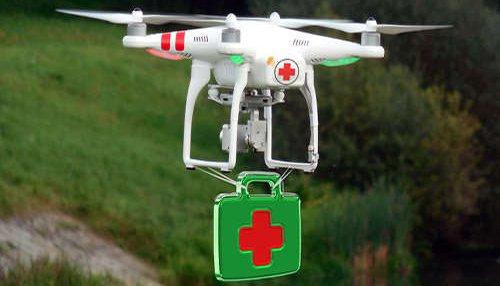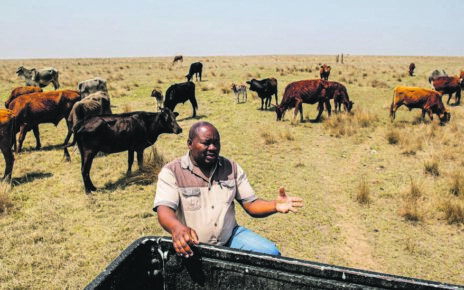This isn’t the first time Flirtey has completed successful missions for the health care field. Last summer, the company was part of the Let’s Fly Wisely event in Wise, Va., where they worked with the Remote Area Medical clinic (RAM), the Mid-Atlantic Aviation Partnership at Virginia Tech (MAAP) and NASA to deliver medical packages to volunteers on the ground, who in turn made sure underserved attendees received the packages—marking the first time a UAS delivered medical supplies and pharmaceuticals in the US.
Stan Brock, founder and president of RAM, a nonprofit organization that provides medical care to remote areas, first became interested in deploying delivery drones a few years ago. At the time, the group had just begun air ambulance operations to bring medicine and vaccines to parts of the upper Amazon rain forest. Manned fixed-wing helicopters fly about every two days to take vaccines, snakebite serum and other medical supplies to remote villages, a more costly and complex operation as compared to using UAS.
“It would be extremely helpful if we were able to send packages of medicine and vaccines over great distances by drone,” Brock said. “In that part of Virginia (where Let’s Fly Wisely took place), a large number of underserviced people can’t get out of the house during the winter, particularly during inclement weather, but are in desperate need of blood pressure medicine or whatever medicine it is. A drone could take that medicine to them where a vehicle wouldn’t be able to do so.”
Beyond last year’s demonstration, the team at RAM also has been working with Dennis Strege, owner of MasterFlight Inc., to build a drone prototype specific for this application. The aircraft he’s modifying, which was originally developed for power line inspections, will be able to fly 150 nautical miles with a 55 pound payload. The UAS will be able to withstand harsh weather conditions that would keep manned aircraft grounded and make multiple deliveries throughout the day. Strege described the vehicle as ideal for a program RAM recently started in the Philippines, where they need to deliver medication across long stretches of water.
The UAS also will be equipped with a defibrillator—something Dr. Mark Head, RAM foreign crisis coordinator, Greece, said is a huge step forward in saving time and lives. Alec Mormot began work on developing the first UAS prototype with a defibrillator as a graduate industrial design student at TU Delft University in Holland. In his version, a smart phone app is used to call the drone during an emergency. Once the drone arrives, a medical professional can walk a friend or bystander through how to use the defibrillator over the phone.
“If you can get a drone to a downed person having a heart attack quicker than an ambulance, you can save lives,” Head said. “The thing about a defibrillator is it doesn’t matter how you use it as long as you can get to the patient quickly. It’s the time after the event that’s critical.”
Delivering Care in Rwanda
The UPS Foundation, Zipline and Gavi, the Vaccine Alliance recently formed a partnership to begin transporting blood and vaccines to rural areas in Rwanda. They’re also working closely with the Rwandan government, whose leadership is actively looking for ways to dispatch vaccines and medicine to its citizens, Gavi spokesperson Frédérique Tissandier said.
During the first phase of the 18-month project, which is expected to begin in mid-August, the UAS will deliver blood to transfusion facilities. The blood will primarily be used to save women experiencing postpartum hemorrhaging, which is a common problem in the country, Gavi Manager of Global Operational Partnerships Mozammil Siddiqui said. After evaluating and determining how well the UAS were operated, how many deliveries were made and how the UAS were perceived, the second phase, which involves delivering rabies vaccine, will begin.
“The global health community is looking for new ways to deliver vaccines, increase coverage and protect children against various diseases,” Tissandier said. “With all the mountains in Rwanda it’s hard to get to remote villages. Some places can only be reached by boat. We’re using this partnership to save kids’ lives and protect them from vaccine-preventable disease.”
Time is critical in emergency situations, especially when victims need blood or a rabies vaccine, Siddiqui said. If a child in Rwanda is bitten by a rabid animal, for example, instead of waiting hours to get the necessary vaccine, a UAS can deliver it in about 15 minutes. This type of use is why Gavi has been looking into using drones for vaccine delivery for a few years now. They just needed the right partners to help them move forward, which they found through Zipline and its drone’s capabilities and the UPS Foundation’s logistic expertise.
While drone delivery makes it possible to courier needed vaccines to remote areas in harsh weather, it isn’t without its challenges. Both blood and the vaccines must be kept at a certain temperature during transport, Siddiqui said, or they will be unusable when they arrive. Anyone working with the payloads must be properly trained to ensure the products arrive at the right temperature and that deliveries go smoothly.
Zipline has been developing the UAS, known as Zips, for the last two years, software team lead Ryan Oksenhorn said. The drones have the ability to complete about 150 blood deliveries a day to transfusing facilities in the western half of the country. The development team had to overcome a variety of challenges, such as finding a way to make deliveries without actually landing at the site and creating a UAS designed for this type of long-distance delivery.
“Virtually all emergency medical products are small and lightweight but also high value,” Oksenhorn said, noting clinics that once only received deliveries a few times a year will now receive deliveries a few times a day. “It makes perfect sense to use this technology very cheaply and very quickly to travel long distances. Right now it costs $10,000 to emergency lift someone in a helicopter to go to the hospital if they need blood. For orders of magnitude less money and less time you can deliver the blood with a drone. There’s no need to send several humans in a helicopter. You can send the blood directly to the person who needs it.”
Oksenhorn said the work in Rwanda is just a start and he hopes to see Zips used to deliver blood, vaccines and medication in remote locations all over the world.
In fact, Zipline recently announced it will soon begin flying missions in the U.S., according to the company. Zipline is partnering with Ellumen, ASD Healthcare and Bloodworks Northwest to deliver blood, medicine and medical products to rural/remote communities in Maryland, Nevada and Washington State, including Indian reservations and their surrounding communities. Flights are expected to begin six months after regulatory approval.
Hospital Deliveries
Today, much of the research involving health care-related drones centers around delivery to remote areas, but that’s not the only way UAS can benefit this industry. Will Stavanja, founder of consulting company Wilstair, is among those looking into how UAS can be used inside hospitals.
One way is by transporting blood samples and medications from floor to floor or building to building, rather than making such deliveries by foot or through the pneumatic tube systems hospitals typically use, Stavanja said. This can be particularly helpful for growing hospitals making additions. Expanding a pneumatic tube system is a costly endeavor, but using a drone instead gives hospitals the ability to transport specimens and medications from floor to floor at a low cost.
“As the technology continues to advance, a small drone can be scheduled to deliver medicine at 3 in the afternoon to room X,” he said. “As long as each of the waypoints are programmed for the drone’s trajectory, the drone can complete operations a pneumatic tube can’t.”
While Stavanja is excited about the potential uses for drones inside hospitals, like most UAS applications, there are several challenges to making it a reality. The first is communication. Outdoor drones rely on GPS signals and radio frequencies to complete their missions, both of which are limited indoors. Blue tooth technology might offer a solution to that challenge, but researchers also need to figure out a way to fully automate drones so they understand their environment and remember where they are. Then there’s the weight. Typically the smarter the UAS, the larger it is—and the more expensive. To keep costs down, these drones will need to be small. And of course, safety is always a concern, as well as the battery life needed to get from point A to point B.
Many of the people reluctant to use drones inside hospitals are worried it could cost people their jobs, Stavanja said. But he argues it will free them up to spend more time with patients and focus on other tasks. There will also be a need for people to provide flight paths and manage the drones to ensure they’re transporting the right package at the right temperature to the right location.
“With a smart phone app nurses can indicate they need such and such delivered to room X and the drone can be immediately programed to do so,” Stavanja said. “This also gives hospitals the opportunity to use existing staff to do other jobs and support other demands of the hospital. Drones can take on some of the smaller roles such as moving meds from floor to floor. This means patients receive better care.”
Helping the Elderly
Research is also being done to find ways to use drones to benefit the growing senior population. For the last year Naira Hovakimyan, W. Grafton and Lillian B. Wilkins professor of mechanical science and engineering at the University of Illinois at Urbana-Champaign, has been working on a project designed to help the elderly age in place rather than spend their final years in a nursing home. Small drones with manipulator arms can be used to bring them medication, grab a glass of water, clean a chandelier, pick something up from under the table or even sort laundry.
Not only is robotics important to this type of research, so is the psychology, Hovakimyan said. The team must develop flight paths that humans find both safe and acceptable. To that end, the team is working closely with psychology experts.
“We’re immersing people in virtual reality where these drones are flying around them,” Hovakimyan said. “Depending on people’s reaction, including heart rate and head tilt, we can revise the drone design to make sure it’s safe for people.”
The main challenge is developing a robot that is as reliable as your refrigerator or washer, Hovakimyan said. But unlike your refrigerator or washer, these drones must be able to move around all over the home and reliably deliver every time, whether they’re fetching medicine or cleaning. Researchers must also create a drone that elderly from all different backgrounds will consider safe. For it to work, they must feel comfortable interacting with it.
Other Challenges
As with every industry interested in implementing UAS, there are challenges to overcome ranging from payload capacity to battery life and, of course, regulations, Tucker said. A lot of the research being done for health-related delivery services is happening in other countries because the restrictions make it too difficult to complete testing in the U.S. And while the new Part 107 regulations the Federal Aviation Administration released earlier this summer remove some of the limitations, some uncertainty remains. But as the barriers start to come down, Tucker sees more people in the industry becoming interested in UAS and reaping the many benefits the technology can provide, starting with delivery services and then moving on to more complicated applications in the next five to 10 years.
“The early adopters are there. I know colleagues who are testing these solutions on their own,” Tucker said. “Early adopters are out there trying to work with these solutions but there are barriers. Some people are just reluctant. They’re reluctant to spend money on new technology because they’re wondering what the cost is going to be and they’re worried about making a business case for it because of the regulations. The FAA has been the biggest barrier, but that is starting to change.










